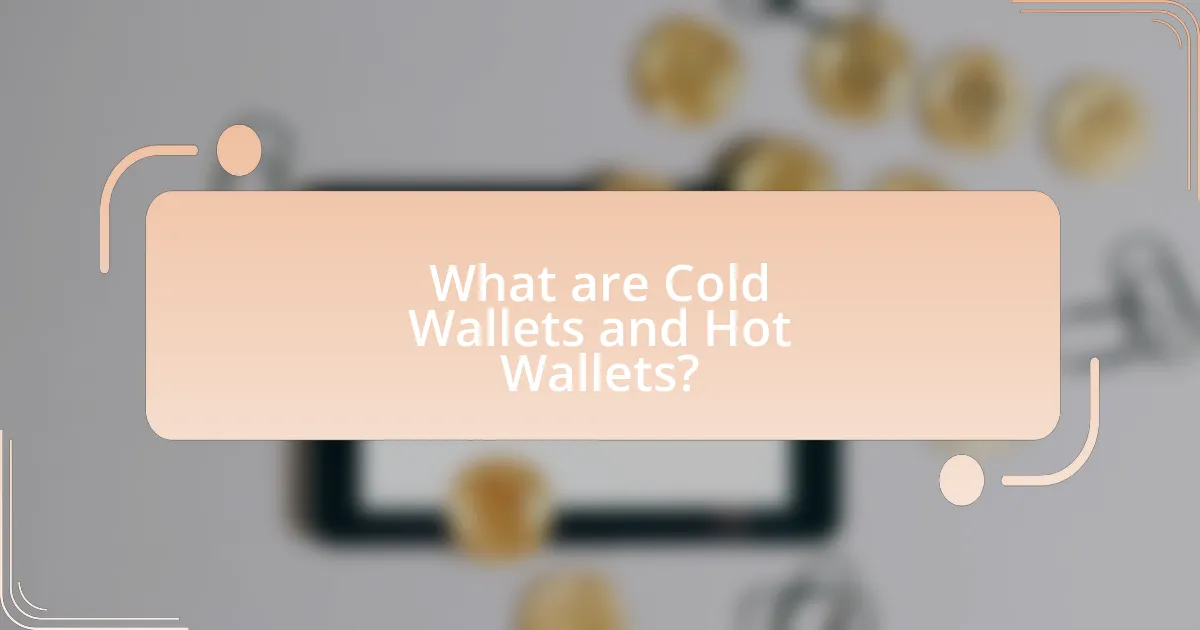Cold wallets and hot wallets are two primary types of cryptocurrency storage solutions, each serving distinct purposes in managing digital assets. Cold wallets, which include hardware and paper wallets, provide enhanced security by storing cryptocurrencies offline, significantly reducing the risk of hacking. Conversely, hot wallets, such as mobile and web-based wallets, offer quick access and convenience for transactions but are more vulnerable to cyber threats. This article explores the key characteristics, advantages, and disadvantages of both wallet types, emphasizing their importance in cryptocurrency security and management, as well as best practices for their use.

What are Cold Wallets and Hot Wallets?
Cold wallets and hot wallets are two types of cryptocurrency storage solutions. Cold wallets, also known as cold storage, are offline devices or methods used to store cryptocurrencies securely, making them less vulnerable to hacking. Examples include hardware wallets and paper wallets. In contrast, hot wallets are connected to the internet and allow for quick access and transactions, but they carry a higher risk of being compromised. Common examples of hot wallets include mobile apps and web-based wallets. The distinction between these two types is crucial for users to manage their cryptocurrency security effectively.
How do Cold Wallets differ from Hot Wallets?
Cold wallets differ from hot wallets primarily in their connectivity to the internet. Cold wallets, such as hardware wallets or paper wallets, are offline storage solutions that provide enhanced security against hacking and online threats. In contrast, hot wallets are connected to the internet, making them more convenient for transactions but also more vulnerable to cyber attacks. According to a report by the Blockchain Security Alliance, cold wallets can reduce the risk of theft by up to 95% compared to hot wallets, highlighting their effectiveness in safeguarding digital assets.
What are the key characteristics of Cold Wallets?
Cold wallets are secure storage solutions for cryptocurrencies that are not connected to the internet. Their key characteristics include enhanced security, as they are less vulnerable to hacking and online threats; offline storage, which protects private keys from unauthorized access; and various forms, such as hardware wallets and paper wallets, which provide different methods of safeguarding digital assets. Additionally, cold wallets typically require physical access for transactions, making them ideal for long-term storage of cryptocurrencies.
What are the key characteristics of Hot Wallets?
Hot wallets are digital wallets that are connected to the internet, allowing for quick and easy access to cryptocurrencies. Their key characteristics include high accessibility, as users can send and receive funds instantly; convenience, since they are often integrated with exchanges and mobile applications; and vulnerability to security risks, as being online exposes them to potential hacking and phishing attacks. According to a report by Chainalysis, over 60% of cryptocurrency thefts occur from hot wallets, highlighting the importance of understanding their risks.
Why are Cold Wallets and Hot Wallets important in cryptocurrency?
Cold wallets and hot wallets are important in cryptocurrency because they serve distinct purposes in securing and managing digital assets. Cold wallets, which are offline storage solutions, provide enhanced security against hacking and online threats, making them ideal for long-term storage of cryptocurrencies. In contrast, hot wallets are connected to the internet, allowing for quick and easy access to funds for transactions, which is essential for active trading and daily use. The importance of these wallets is underscored by the fact that, according to a report by Chainalysis, over $3.2 billion in cryptocurrency was stolen in 2020, highlighting the need for secure storage options.
How do these wallets impact security in cryptocurrency transactions?
Cold wallets enhance security in cryptocurrency transactions by storing private keys offline, making them less vulnerable to hacking. In contrast, hot wallets, which are connected to the internet, expose private keys to potential online threats. According to a report by CipherTrace, 2020 saw over $1.8 billion lost to cryptocurrency theft, primarily from hot wallets. This data underscores the importance of using cold wallets for secure storage, as they significantly reduce the risk of unauthorized access and theft.
What role do they play in managing digital assets?
Cold wallets and hot wallets play crucial roles in managing digital assets by providing secure storage and accessibility options. Cold wallets, which are offline storage solutions, protect digital assets from online threats, making them ideal for long-term storage. In contrast, hot wallets are connected to the internet, allowing for quick access and transactions, which is beneficial for active trading. The combination of both types enables users to balance security and convenience, ensuring that digital assets are both protected and readily available when needed.

What are the advantages and disadvantages of Cold Wallets?
Cold wallets offer significant advantages and disadvantages. The primary advantage is enhanced security; cold wallets store cryptocurrencies offline, making them less vulnerable to hacking and online threats. For instance, hardware wallets like Ledger and Trezor are designed to keep private keys secure, reducing the risk of theft. Conversely, the main disadvantage is reduced accessibility; users cannot easily access their funds for transactions, as cold wallets require physical access to the device or medium. This can lead to inconvenience, especially in urgent situations where quick access to funds is necessary.
What benefits do Cold Wallets provide for users?
Cold wallets provide users with enhanced security for their cryptocurrency holdings by storing private keys offline. This offline storage significantly reduces the risk of hacking and unauthorized access, as cold wallets are not connected to the internet. According to a report by the Cybersecurity and Infrastructure Security Agency, offline storage methods are among the most secure ways to protect digital assets. Additionally, cold wallets often support multiple cryptocurrencies, allowing users to manage various assets in one secure location.
How do Cold Wallets enhance security for cryptocurrency holdings?
Cold wallets enhance security for cryptocurrency holdings by storing private keys offline, thereby reducing exposure to online threats. This offline storage method protects against hacking, malware, and phishing attacks, which are prevalent in online environments. According to a report by the Blockchain Security Alliance, cold wallets are considered one of the safest methods for securing digital assets, as they are not connected to the internet and thus are immune to remote access by cybercriminals.
What are the limitations of using Cold Wallets?
Cold wallets have several limitations, primarily related to accessibility and usability. Users cannot easily access their funds for transactions, as cold wallets require a physical device or paper to retrieve private keys, making them less convenient for frequent trading. Additionally, cold wallets are vulnerable to physical damage or loss; if the device is destroyed or misplaced, access to the stored cryptocurrencies can be permanently lost. Furthermore, the setup process for cold wallets can be complex, requiring technical knowledge that may deter less experienced users. These limitations highlight the trade-offs between security and convenience when choosing a storage solution for cryptocurrencies.
When should you consider using a Cold Wallet?
You should consider using a cold wallet when you want to securely store cryptocurrencies for long-term holding without the risk of online hacking. Cold wallets, which are offline storage solutions, protect your assets from cyber threats, making them ideal for individuals who do not require frequent access to their funds. According to a report by the Blockchain Research Institute, cold wallets significantly reduce the risk of theft compared to hot wallets, which are connected to the internet and more vulnerable to attacks.
What types of users benefit most from Cold Wallets?
Users who benefit most from cold wallets are long-term cryptocurrency holders and institutional investors. Long-term holders prefer cold wallets for their enhanced security features, as these wallets store private keys offline, significantly reducing the risk of hacking. Institutional investors also favor cold wallets due to regulatory compliance and the need for secure asset management, as evidenced by the increasing adoption of cold storage solutions among major financial institutions to protect large amounts of digital assets.
How does the amount of cryptocurrency influence the decision to use a Cold Wallet?
The amount of cryptocurrency significantly influences the decision to use a Cold Wallet, as higher amounts typically necessitate enhanced security measures. Individuals holding substantial cryptocurrency assets are more likely to opt for Cold Wallets due to their offline storage capabilities, which protect against hacking and online theft. For instance, a survey by the Cambridge Centre for Alternative Finance in 2021 indicated that 61% of cryptocurrency holders with investments exceeding $10,000 preferred Cold Wallets for their enhanced security features. This trend underscores the correlation between the value of cryptocurrency holdings and the choice of storage method, as larger investments warrant greater protection against potential risks.

What are the advantages and disadvantages of Hot Wallets?
Hot wallets offer the advantage of convenience and accessibility, allowing users to quickly send and receive cryptocurrencies. This is particularly beneficial for frequent traders or those who need immediate access to their funds. However, the primary disadvantage of hot wallets is their vulnerability to hacking and cyber attacks, as they are connected to the internet. According to a report by Chainalysis, in 2021, over $3.2 billion was stolen from hot wallets, highlighting the significant security risks associated with their use.
What benefits do Hot Wallets offer for cryptocurrency users?
Hot wallets provide cryptocurrency users with immediate access to their funds and facilitate quick transactions. This accessibility is crucial for users who engage in frequent trading or require instant payments. Additionally, hot wallets often come with user-friendly interfaces and support for multiple cryptocurrencies, enhancing the overall user experience. According to a report by Chainalysis, the ease of use and speed of transactions in hot wallets make them popular among active traders, who prioritize liquidity and convenience.
How do Hot Wallets facilitate quick transactions?
Hot wallets facilitate quick transactions by maintaining a constant internet connection, allowing for immediate access to funds. This connectivity enables users to send and receive cryptocurrencies rapidly, as transactions can be processed without the delays associated with offline storage solutions. For instance, hot wallets can execute transactions in seconds, compared to cold wallets, which require additional steps to access funds. The speed of hot wallets is crucial for trading and everyday transactions, where timing can significantly impact financial outcomes.
What are the risks associated with using Hot Wallets?
Hot wallets are susceptible to various risks, primarily due to their constant connection to the internet. This connectivity makes them vulnerable to hacking, where cybercriminals can exploit security weaknesses to steal funds. For instance, in 2020, the KuCoin exchange suffered a hack that resulted in the loss of over $280 million from its hot wallet. Additionally, hot wallets can be compromised through phishing attacks, where users are tricked into providing their private keys or login credentials. Furthermore, the reliance on third-party services for security increases the risk of mismanagement or breaches, as seen in multiple incidents involving exchanges. Overall, the inherent online nature of hot wallets exposes them to significant security threats.
In what scenarios are Hot Wallets the preferred choice?
Hot wallets are preferred in scenarios requiring quick access to funds and frequent transactions. They are ideal for active trading, where users need to buy and sell cryptocurrencies rapidly, as well as for everyday transactions, such as purchasing goods and services. The convenience of hot wallets, which are connected to the internet, allows for immediate transfers and real-time market engagement, making them suitable for users who prioritize speed and accessibility over long-term security.
How do trading frequency and user experience affect the choice of Hot Wallets?
Trading frequency and user experience significantly influence the choice of Hot Wallets. Users who trade frequently prefer Hot Wallets for their quick access and convenience, allowing for immediate transactions without the delays associated with Cold Wallets. Conversely, users with less trading activity may prioritize security over speed, opting for Cold Wallets to safeguard their assets. Research indicates that 70% of active traders utilize Hot Wallets due to their ease of use, while only 30% of infrequent traders choose them, highlighting the correlation between trading frequency and wallet selection.
How can you choose between a Cold Wallet and a Hot Wallet?
To choose between a Cold Wallet and a Hot Wallet, assess your security needs and usage frequency. Cold Wallets, such as hardware wallets, provide enhanced security by storing cryptocurrencies offline, making them ideal for long-term storage and minimizing exposure to online threats. In contrast, Hot Wallets, like mobile or web wallets, offer convenience and quick access for frequent transactions but are more vulnerable to hacking. According to a 2021 report by Chainalysis, 72% of cryptocurrency thefts occurred from Hot Wallets, highlighting their security risks. Therefore, if security is your priority, opt for a Cold Wallet; if you require regular access and ease of use, a Hot Wallet may be more suitable.
What best practices should you follow when using Cold and Hot Wallets?
When using cold and hot wallets, best practices include ensuring strong security measures, regularly updating software, and maintaining a clear separation between funds. Cold wallets, which are offline, should be stored in secure physical locations, while hot wallets, connected to the internet, require robust passwords and two-factor authentication to protect against unauthorized access. Regularly backing up wallet data and keeping recovery phrases secure are essential for both types of wallets. According to a report by Chainalysis, 70% of cryptocurrency thefts occur from hot wallets, emphasizing the need for heightened security in online environments.